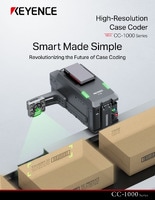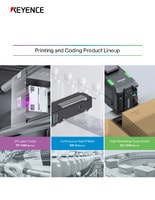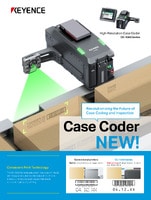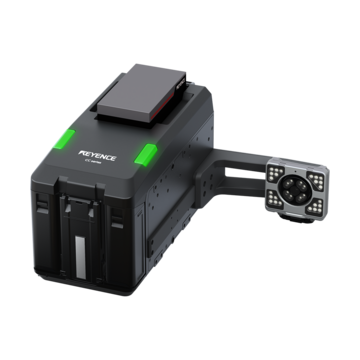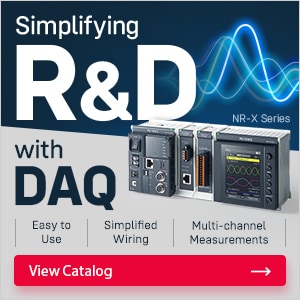Continuous Inkjet Printers / Case Coder
Materials and Products
Production Machines
Printing Applications
Benefits of Integrated Print Inspection
Key Takeaways
- Inline 100% print inspection detects unreadable or missing codes in real time, preventing shipping errors.
- Automatic image capture and data logging enhance traceability and compliance documentation.
- Immediate feedback to printer enables dynamic adjustment, ensuring consistent print quality.
- Eliminates manual checks, reducing labor costs and human error in quality control.
- Integration at full line speed maintains throughput without inspection bottlenecks.

Integrated print inspection combines printing and case coding quality control into one seamless process. Instead of relying on separate packaging inspection systems or manual checks, the operation verifies every print in real time as it’s produced. This not only confirms that codes meet compliance and readability requirements but also keeps production moving at full speed. With the CC-1000 Series, inline print verification is built directly into the case coder, creating a unified solution that raises both quality and efficiency standards.
What Is Integrated Print Inspection?
Integrated print inspection is a process where the printhead and inspection camera operate as one unit, sharing data and configuration for every job. In the CC-1000 Series, this means that when a print file is loaded, the inspection parameters are instantly matched, eliminating the need for a separate device to set up and reducing the risk of misalignment between the print and verification.
The camera checks each printed mark for accuracy, placement, and quality. Any deviation (whether from substrate changes, speed variation, or mechanical vibration) is caught immediately. This approach eliminates the lag and uncertainty of manual checks, where operators inspect only a fraction of the output and rely on visual judgment that can be inconsistent under production pressures.
By combining both processes inside the same hardware, integrated print inspection removes the possibility of inspection drift that happens when inkjet printers and cameras operate independently. The inspection data is tied directly to the print file, so there’s no guesswork when a job changes. This tighter link improves the repeatability of packaging inspection systems and allows every package to meet the same standard without added setup time.
By embedding inspection inside the coder, the CC-1000 Series holds every product to the same standard, whether the run is a few hundred units or tens of thousands at full conveyor speed.
We’re here to provide you with more details.
Reach out today!

Why Print Quality Control Matters on Packaging Lines
Every package leaving a production facility carries both a product and a message. When codes are wrong, missing, or unreadable, the consequences can range from costly rework to intense product recalls. These issues disrupt schedules, and they put regulatory compliance and brand reputation at risk.
In industries with strict labeling requirements, such as food, pharmaceuticals, or consumer goods, print quality inspection checks that every corrugated box meets traceability, scannability, and accuracy standards. The CC-1000 Series’ integrated print inspection gives operators immediate feedback, so deviations are corrected before a full run of defective product is produced. This proactive approach helps prevent wasted materials, protects downstream processes, and reinforces the role of case coding quality control in avoiding non-compliant shipments.
For example, a batch of corrugated cases printed with a slightly stretched barcode. To the naked eye, it appears fine, but at the distribution center, scanners can’t read it. Without inline print verification, that batch might be rejected entirely, resulting in reprints, repacking, and lost shipping windows. Integrated print inspection catches that problem on the first package, eliminating waste and keeping production in sync with delivery schedules.
Avoiding Misprints and Compliance Risks
Misprints aren’t always obvious; a slightly skewed barcode or missing quiet zone can cause a scanner to reject a product, even if it looks acceptable to the eye. That’s where automated print quality inspection provides value beyond human capability.
The CC-1000 Series uses a multi-sensor system to detect and correct the causes of misprints before they impact quality. It compensates for speed changes that could stretch or compress a code, alerts operators to vibration that could blur text, and tracks target distance to prevent distortion. When these controls are combined with high-resolution printing, the system maintains both visual and functional integrity.
Meeting GS1 and other global standards means codes must scan accurately and remain readable in any environment. The CC-1000 Series checks every print against those benchmarks in real time, catching small deviations before they disrupt shipping schedules or trigger costly product holds, further proving the importance of case coding quality control for regulatory compliance.
Curious about our pricing?
Click here to find out more.
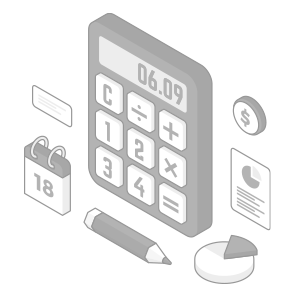
Key Features of Integrated Inspection With the CC-1000 Series
The CC-1000 Series inkjet printer has a 360 DPI resolution and features a long throw distance of up to 15 mm 0.6″, allowing for crisp, consistent printing even when the package position varies slightly. The integrated inspection camera is housed within the same enclosure as the printhead and is controlled from the same touch panel, allowing operators to manage both processes through a single interface.
A built-in multi-sensing unit monitors line conditions in real time. It tracks conveyor speed, detects vibration, triggers the print at the correct moment, and alerts operators to any head collisions. These capabilities help maintain print quality inspection without constant manual oversight.
Maintenance is simplified with a damage-free nozzle cleaning module and one-touch head core replacement. This keeps downtime to a minimum and allows teams to address issues quickly without specialized tools or lengthy procedures.
Real-Time Error Detection and Correction
The MSU integrates multiple sensing capabilities:
- Print triggering that aligns perfectly with product movement.
- Speed change tracking to maintain consistent code density.
- Distance and vibration detection to correct distortions caused by variations in product height or unstable conveyors.
- Head collision detection to protect both the printhead and the product.
This combination allows the CC-1000 Series to adapt dynamically without halting production. Whether the substrate is porous corrugate or smooth film, inspection parameters adjust automatically, keeping codes sharp and compliant.
Discover more about this product.
Click here to book your demo.

How It Boosts Overall Line Efficiency
Combining print and inspection in one system shortens setup time, especially during changeovers. Operators no longer need to align two separate devices or transfer print job data between them. Once the print job is loaded, the inspection parameters are automatically set to match.
This integration also reduces the amount of hardware on the floor, freeing up space and simplifying maintenance schedules. With fewer standalone devices to calibrate, inspect, and service, the line runs more consistently.
In lean manufacturing environments, every minute of uptime and every piece of saved material contributes to the bottom line. By preventing the eight common forms of process waste - defects, overproduction, waiting, non-utilized talent, transportation, inventory, motion, and excess processing - highlighted by Lean Manufacturing principles, the CC-1000 Series aligns with efficiency goals while ensuring consistent quality.
Ensure flawless print quality every time. Contact KEYENCE today to see how the CC-1000 Series’ integrated print inspection can transform your packaging line efficiency, accuracy, and compliance.
Contact us to learn more about how our advanced technology can help take your business to the next level.
Contact Us
FAQs
How Does Integrated Inspection Differ from Manual Label Checks?
Manual label checks rely on operators visually inspecting products at intervals, which can miss defects that occur between samples. Integrated inspection, like the CC-1000 Series’ built-in system, monitors every single print in real time and adjusts instantly if a deviation occurs and eliminating the gaps and delays inherent in manual processes, maintaining consistent quality across the entire run.
Can Print Inspection Systems Integrate with Legacy Equipment?
Yes, many inspection systems can be added to an existing line without requiring major rebuilds, and the CC-1000 Series facilitates this process more efficiently. Its mounting hardware adjusts to various conveyor layouts, and its I/O connections are compatible with older control systems. That means it can take over print quality checks immediately, without weeks of downtime or custom engineering.
Is Inspection Needed if the Codes Are Legible to the Eye?
Legibility to the human eye doesn’t always mean a code is compliant or scannable. Even small distortions, fading, or misalignment can cause barcode readers or vision systems to fail, which can disrupt downstream processes or lead to compliance issues. Integrated inspection verifies print quality to machine-readable standards, confirming that codes pass both visual and automated checks.
We’re here to provide you with more details.
Reach out today!

Related Downloads
Related Products
Applications
Materials and Products
- Glass Bottles
- Plastic Bottles/Containers
- Cans
- Wires, Cables, & Pipes
- Pouches
- Metal Parts
- Corrugate Boxes
- Packaging Film
- Kraft Packaging
- Folding Cartons
- Building Materials
- PCBs
- Cartons
- Pallets & Lumber
- Corrugate Trays
Production Machines
- Paper Bag Packaging
- Box Conveyor
- Automatic Palletizer
- Sealer/Taping Machine
- Bottle Filling Machine
- Flow Wrapper

